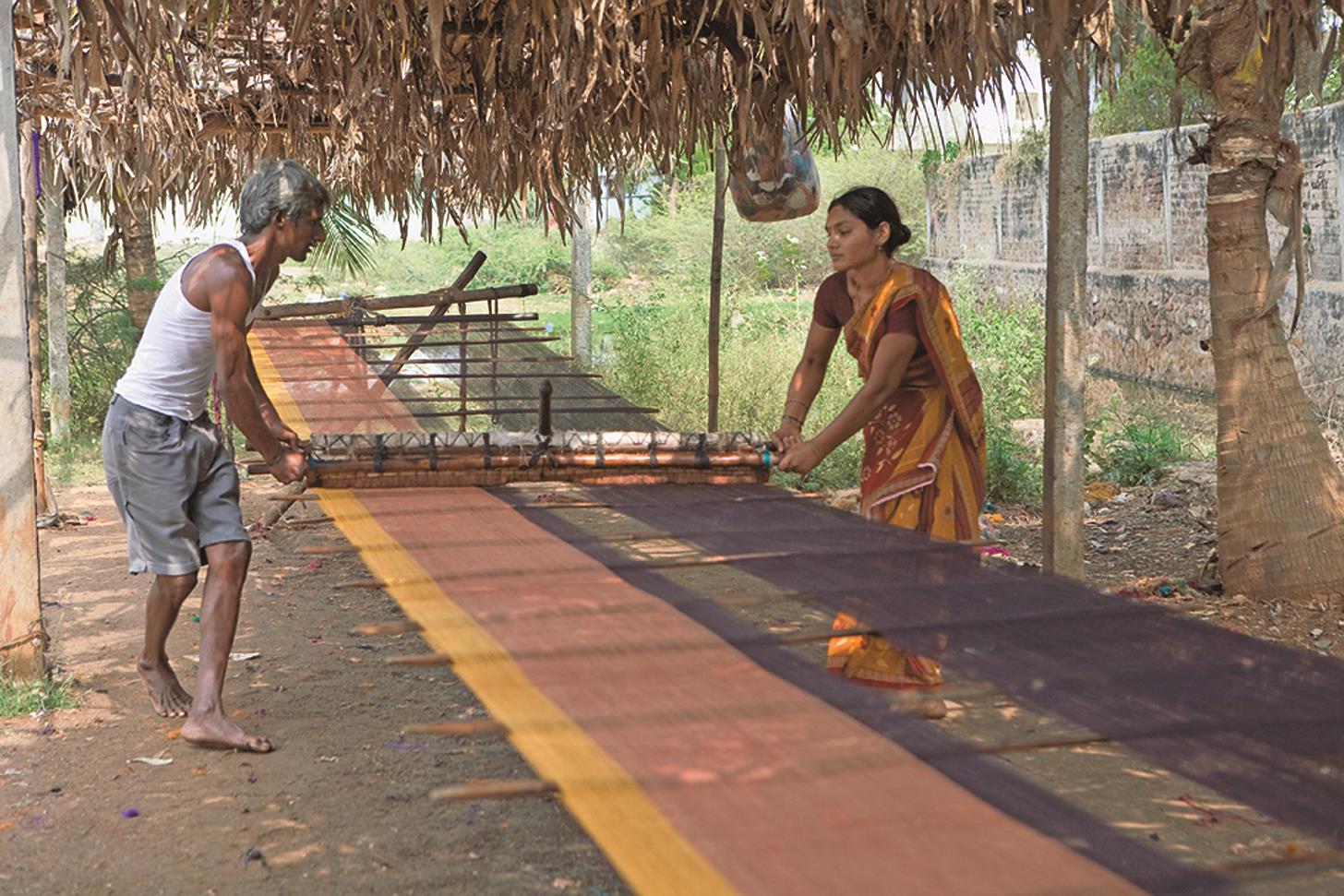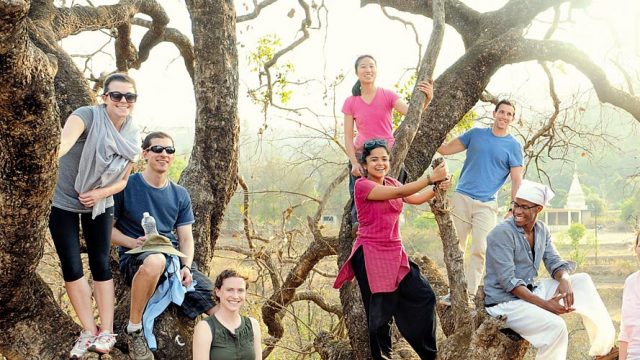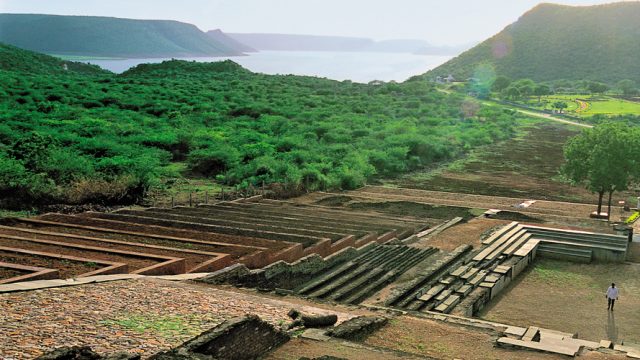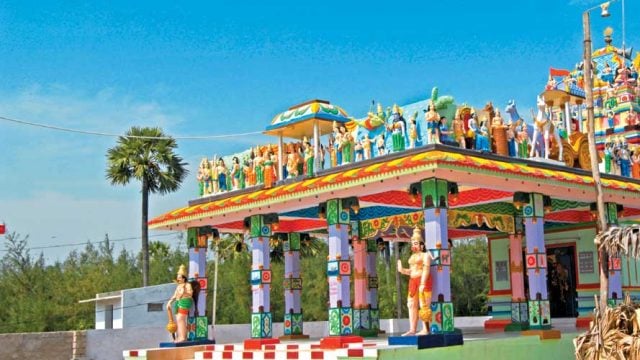The room was packed to the rafters with six looms. In their interstices were the men and
A handloom is an anachronistic machine.It is made of bits of wood and twine, with a roll of jacquard punch cards creating a canopy. Very nineteenth century. The men and women who work these looms also lead nineteenth-century lives. They are landless, their skill is their only asset. In the absence of collateral, they are shunned by banks and fall prey to ravenous loan sharks. Crippled by debt and virtually indentured to middlemen who pay them starvation wages, they work ten-to-twelve-hour days, with prematurely dimmed vision and arthritic limbs. The absent Indian state offers no protection. What supports this bubble of anachronism?
To find out, I travelled through Andhra Pradesh, the state with the highest concentration of distinct handloom weaves and 2.5 million weavers. I crisscrossed this vast state and logged nearly 2,000km over a week visiting Gadwal, Narayanpet, Pochampally, Mangalagiri, Uppada and Venkatagiri. The terrain varied as widely as the textiles
Some of these villages were in the parched west, some on the lush coast, some cradled by the Eastern Ghats. Some of the saris were silk, others cotton; some had jacquard zari borders, others were ikat, still others were meticulously hand-tied jamdani. But no matter where I went, the weavers appeared to be living the same script. This is the story of the battered custodians of one of the last bastions of original India.
Gadwal is a three-hour drive south from Hyderabad, through barren scrubland dotted with knolls bearing smooth chocolate boulders in gravity-defying formations. The Jurala reservoir sucks all the blue out of the mighty Krishna here, leaving behind a scabrous ochre gash. Gadwal resembles the post-harvest hay in its surrounding fields — spent, but with rich hints of a fecund past. Within the ramparts of its crumbling mud fort is an old stone temple, along whose raised foundation are carved rows of hamsas — mythical swans with rich plumage, interlocked tendrils and diamond motifs, all of which waft into the saris on the looms here. Gadwal’s legendary saris used to have cotton bodies with elaborate zari-brocaded silk borders and pallu. But at Rs 5,000 and above apiece, the market no longer supports cotton, so most weavers here work only with silk.
The weaver colony is a warren of squat one-storey homes: brick-and-mortar with slate slab floors, each with a front ‘loom’ room that doubles as a living area and a tidy kitchen in the back. When I walked into Padma and Krishnaiyya’s home, they had broken for lunch. Padma is a wiry woman with a kilowatt smile. She had paused her work on a purple silk sari with an intricate gold border, and chatted while pounding out a peanut-chilli chutney in her kitchen. Both she and Krishnaiyya are generational weavers. They have Rs 300 in the bank and about Rs 40,000 in debt. They work for middlemen and together manage about four saris a month at Rs 1,000 per sari. No, none of their daughters are going to be weavers. Two have been married to non-weavers and the third, Lalitha, is studying at a polytechnic in town. No, Padma has never owned a Gadwal sari. But yes, she will make one for Lalitha’s trousseau with her own hands. As she said this, she blinded me with her smile and gave me a dab of chutney to taste.
Any residue of this smile was torched by incandescent rage in Narayanpet, two hours northwest of Gadwal on gnarly rural roads. This desiccated speck on the Karnataka border produces distinctive cotton saris with brocaded rudraksh motifs. Outside the local chapter of APCo, the state handloom co-op, Srinivas explodes: “They give us Rs 60 per sari, which takes one or two days. Rs 60! And I am a fourth-generation weaver.” He manages about twenty saris per month working ten-hour days. His home is an empty shell. He has already eaten one loom, a limp sari hangs unfinished on the other, a stunning mauve-pink piece. His face is as arid as the surrounding land, but he remembers to offer me some grapes. APCo’s local chairman later says of Srinivas, “He is financially weak,” sounding like a kind doctor diagnosing a genetic disorder.
Srinivas’ situation is more precarious than Padma’s but the similarities stand out. Other than food, they both work mainly to service their debt. The work is technical but there is no room for imagination; they implement designs from on high. Despite being generational weavers, there is no volition or joy in this work. Like hamsters on a wheel, they can’t get off. But they have resolved that their children will, a refrain I heard from destitute Narayanpet to flush Uppada. The children of these weavers are not going to be weavers. This writing on the wall is in boldface.
Pochampally is an hour east of Hyderabad through suburban sprawl and red dust. Smack in the middle of the village is a gated community: a confection of red-tiled cottages and landscaped greens—APTDC’s Rural Tourism Complex. Outside, the weavers’ colony bakes in the sun: a cracked wooden door; a threshold lovingly painted; a worn ikat curtain swollen with breeze. The logo of Pochampally’s weavers’ co-op is an image of a weaver at a loom encircled by these words: “Salvation of India lies in cottages.”
When I stepped into Jagataiyya Padmashali’s home, he was taking a well-deserved nap. Stately and tall at seventy-four, he has been a lifelong weaver. Pochampally is famed for its ikat textiles, where the yarn, tie-dyed before weaving, produces jagged geometric patterns. Jagataiyya’s home had two looms, both bearing lovely silk pieces in progress. In one corner, a moon-faced woman sat spinning the charkha. Out in the yard, a man was dyeing yarn after carefully tying it with fat rubber bands. This family of six, working together, manages to produce seven saris a month—and gets Rs 500 per sari. Jagataiyya said without a trace of steam: “In another ten years, there will be no Pochampally weavers.”
What do the hands in ‘handloom’ really do? A sari has a long dimension (warp) and a short (weft). The weaver dyes the yarn and prepares the warp, which takes up an entire sari length and is hence done outdoors at the mercy of the weather. He then sets up the loom, prepares the weft shuttle and begins to weave, throwing the shuttle one weft-line at a time. The more complex the weave, the more work per weft-line. For brocade motifs such as at the border, he uses a cyclic sheaf of jacquard punch cards: one card per weft-line, a series for the motif, which cycles as the weave progresses. The work demands precision and is fault-intolerant. This cache of technical knowledge has historically bestowed status to weavers in casteist India, and now acts as a cruel deterrent to change.
After days in parched west Andhra, the country around Mangalagiri, just south of Vijayawada, felt improbably green. The land here is nourished by the Krishna in all its fullness just before it meets the sea. In every direction lay fecund coastal Andhra: rice, corn, sugarcane, groundnut, red chillies, and acres upon white acres of cotton, just days from harvest. This is an old place; nearby is Amaravati, where Ashoka built a stupa in the third century BC that was later gloriously embellished by the Satavahanas during 130–200 AD. In the museum adjoining the site, I browsed the intricately carved fragments, some over 2,000 years old, bearing men and women gracefully draped in yards of unstitched weaves. Here was fresh reminder of the antiquity and continuity of this tradition.
Mangalagiri’s signature cotton saris have a peaked ‘Nizam’ border and a ‘missing thread’ weave for improved ventilation. I found a group of weavers in an unventilated hut fitted with pit looms, where the weaver sits with his legs hanging into a dugout in the mud floor. These men work for a textile business whose fancy shop-front I saw in town, and make about Rs 2,400 per month. S. Vashi, a fifth-generation weaver, said with a rueful smile: “If the government wasn’t providing subsidised rice at Rs 2 a kg, I would starve.” Is there a union? “No.” Have you considered stopping work to negotiate better pay? “What would we eat?” Suddenly the surrounding acres of verdant paddy become an oppressive backdrop.
The drive to Uppada from Vijayawada took me north through the verdant delta of the Godavari, over its two massive arms—Gautami and Vashisht—as it splits in its rush to the sea. En route, I thought about how challenging it was to find a showroom in Hyderabad that stocked Uppada saris. “Too expensive,” was the common refrain. Past Kakinada, the drive was right along the beach, the air ripe with salted fish drying in the sun. Uppada is part fishing village and part handloom celebrity, known for its silk jamdani saris. In the spotless weavers’ colony, Veeranna lives in a brand new two-storey house at the edge of a vast paddy. A room upstairs had three looms with two children per loom, none looked a day above thirteen. “My relatives,” said Veeranna. One waif-like girl sat in a worn school dress doing jamdani work on a turquoise and gold sari that Veeranna said he will sell for Rs 18,000 and the shop in turn may sell for Rs 30,000.
In jamdani work, tiny shuttles of contrast thread are passed through each weft-line to compose whole-body patterns that look the same forward or back. This most labour- and time-intensive of weaves is indigenous to Bangladesh, particularly Dhaka. The silk jamdani work I saw in Uppada and Venkatagiri is not as intricate as Dhaka’s muslin jamdani with its fine-grain slanting floral networks. The patterns here are coarse: large flowers with fleshy petals, done with silver or gold zari on silk in psychedelic shades. Be that as it may, Uppada’s jamdani saris have been fetching prices as high as Rs 3 lakh since it got the Geographical Indication (GI) status two years ago. This has surely improved the lives of Uppada’s weavers but does not appear to have impacted the textiles.
Back in Vijayawada, it was 10.30pm and the train to Tirupati was late. I was camping at the station’s ladies’ waiting room when a woman walked in. She was beautiful and diamond-encrusted, but it was her elegant sari that caught my eye: a subtle grey body with pale yellow ‘shot’ effect and a lively turmeric border with gold brocade. And all this in soft, fine cotton. What type of sari, I ask. Venkatagiri, she says. It’s clearly a sign. That’s where I’m headed.
Venkatagiri is an hour north of Tirupati, past paddies framed by the blue contours of the Eastern Ghats. Patronised by the local royals, the Padmashali and Devangi communities have woven superfine cotton textiles here for centuries. Until recently, Venkatagiri used to produce 200-count cotton—saris with 200 warp-lines. It is still one of the few places in India that makes 100-count cotton saris, with 60- or 80-count being the norm. But this is about to change. Venkatagiri has been doing silk jamdani work for about fifty years, much longer than Uppada. And yet, Uppada has pulled ahead with its GI status. In a scramble to compete, few weavers here are now doing cotton work. I could not find anything remotely resembling the station-woman’s sari in the stores here.
Venkatagiri’s Devangi weaving colony of Bangarupet is a picturesque cluster of whitewashed homes along straight metalled roads radiating out from a temple to the village deity, Sitalamma. Today being her festival, there is fresh rangoli on every stoop. Folks are out tying warps, spinning charkhas and shooting the breeze. The air is of quiet prosperity. I was being shown around by K. Mallikarjun, fifty-seven, a pint-sized dynamo with a leonine head and an easy smile. Mallikarjun won the textile ministry’s national award in 1996 for his silk jamdani work. He has since trained numerous weavers, still weaves himself and employs twenty others who implement his designs. Lokesh is one such employee who makes about Rs 7,000 per month. But Mallikarjun said he had trouble completing an order recently. He couldn’t gather up enough hands because the local MLA had started an irrigation project. Even here, in relative prosperity, digging ditches is a more lucrative option.
So where does that leave us? Our nineteenth-century textile bubble has been slowly leaking air. Over the past 150 years, the subcontinent has lost countless exquisite weaves, some of which can only be seen now as swatches in London’s V&A textile museum. Perhaps the recent spate of wage stagnation with raging food inflation is simply going to speed up the loss. Until then, there will be a slip of a girl who no longer goes to school but works 8am to 5pm, in her school dress, on an Uppada jamdani sari.
Wrap your handloom pieces close around you, those hands are about to disappear.
The information
Currently, there are no organised textile tours of Andhra Pradesh, so this is a very DIY trip. Also, given the far from ideal working conditions of many of Andhra’s weavers, while this can certainly be an eye-opening—perhaps even transformative — trip, it will not necessarily be a cheerful one. If you’re passionate enough about textiles to still want to do the trip, this information might be useful.
The Itinerary
We visited Gadwal, Narayanpet, Pochampally, Mangalagiri, Venkatagiri, Uppada and the kalamkari village of Srikalahasti. With the exception of Pochampally, none of these have any visitor support and some are difficult to reach. You are also unlikely to get anywhere without help from the local administration; try calling APTDC (aptdc.in) ahead of time . The weavers work in their homes and understandably don’t want you to barge in unless you are with someone they know.
Day 1–2
Hyderabad–Gadwal–Narayanpet–Pochampally
Getting there: Hyderabad is connected to all major Indian cities by rail and air. Gadwal is a three-hour drive south, much of it on the smooth NH-7. Narayanpet is a much bumpier two-hour drive northwest from Gadwal. If you can get an early start, Gadwal and Narayanpet can be combined into a day trip from Hyderabad. Pochampally is an hour east of Hyderabad, an easy half-day trip. An AC Tata Indica is typically Rs 7/km with a daily minimum of 250km, plus Rs 250 overnight charge.
The weaves: Gadwal’s richly brocaded saris are a distinctive combination of cotton and silk—a cotton body with a silk border and pallu. The contrasting pallu and borders carry signature motifs influenced by the traditional stone and woodcarvings of the area, such as the hamsa, the double-headed eagle and the stylised lion.
In Narayanpet, the cotton saris have a rich pallu with a unique pattern of alternating red and white bands. The border is usually a flat expanse of deep maroon-red or chocolate-red thinly separated by white or coloured lines, with rudraksh or hamsa motifs brocaded in gold.
The ikat saris in Pochampally come in both cotton and silk: single-ikat if only the yarn in the weft shuttle is tie-dyed, and double-ikat if the yarn on the warp is tie-dyed as well. Pochampally’s ikat tradition is newer than, and the work not quite as refined as, Gujarat’s patola or Sambalpuri ikat.
What to see: Pochampally’s Rural Tourism Complex (kalanetha.com) has a weaving museum. The best part is that the guides are generational weavers from the surrounding village; they will demonstrate the weave for you and may let you try your hand at it.Where to stay: Hyderabad has hotel options for every budget. We stayed at the APTDC’s Taramati Baradari (Rs 1,600 doubles; 040-23521884). At Pochampally, you can spend the night at APTDC’s Rural Tourism Complex (Rs 750 doubles; 0868-5222777).
Day 3–5
Vijayawada–Mangalagiri–Uppada
Getting there: There are several trains that connect Hyderabad and Vijayawada, including the Visakha Express (Rs 590 on 3A) and the overnight Narasapur Express (Rs 602 on 3A). Mangalagiri is just 12km south of Vijayawada, across the Krishna. The drive to Uppada is much longer. From Vijayawada, we drove for five hours to get to Kakinada, where we stopped for the night. Uppada is 20km away from Kakinada, the second half of which is a gorgeous beach drive.
The weaves: Mangalagiri saris are 80-count fine cotton saris. A signature style is the missing thread-weave with a net-like texture and a Nizam border, which looks like a series of flattened Charminars brocaded in gold.
Uppada is known for its whole-body jamdani work with gold and silver zari on silk. An average piece takes two weavers one month.
What to see: Mangalagiri is dominated by a picturesque old temple on a hill. Carved on the stone steps leading to the temple are historical records of old conquests and land grants. The ancient site of Amaravati is less than an hour’s drive away. En route are the Undavalli caves, a cloister of cells for Buddhist monks carved out of a rock face sometime in the second century.
Where to stay: There are plenty of options in Vijayawada but you can’t do better than APTDC’s Haritha Berm Park (Rs 1,200 doubles, 0886-2418057), located right on the Krishna. In Kakinada, the Udipi Vaibhav Residency (Rs 850 doubles, 0884-2355851) is excellent value.
Day 6–7
Tirupati–Venkatagiri–Srikalahasti
Getting there: We took the overnight Tirumala Express (Rs 663 on 3A) from Vijayawada to save time. But you could choose one of the many trains that ply between the two cities through the day. Driving east from Tirupati, you’ll reach Yerpadu (20mins), where there is a fork in the road. If you head north, you’ll reach Venkatagiri (45mins). Further east is Srikalahasti (15mins). Combine both into a one-day trip from Tirupati.
Weaves: Known for its top-grade 100-count cotton saris with gold brocaded border and pallu, which often have slim contrast stripes in the body, Venkatagiri also does silk jamdani work.
Srikalahasti is Andhra Pradesh’s premier hub for kalamkari work: painting on fabric with natural dyes. If you walk into a studio, which typically operates out of small homes, you will be greeted by a powerful stench and a cloud of mosquitoes. That would be the vegetable dyes fermenting in terracotta vats buried in the yard: indigo for blue; haritaki mixed with milk for mustard-yellow; and a blend of date jaggery, palm jaggery and rust for black. You’ll find a bank of kalamkari artists, each holding a bamboo pen with a ball of cotton dipped in dye, tied just behind the nib. They squeeze the dye-ball to determine the thickness of the line, as they bring to life elaborate scenes from the great epics.
What to see: If you like gods with colossal gold reserves, you’ll naturally head to Tirumala. Otherwise, you might consider the ruins of the 11th-century Chandragiri fort, less than an hour outside Tirupati. Or you could head to the Talakona forest (2hrs), and hike up the Talakona waterfalls.
Where to stay: Tirupati is bursting with hotels, but if you want to stay across the street from the train station like we did, you might choose Sudarshan Residency (Rs 750 for doubles, 0877-2266556).
Sari shopping
Unlike handicrafts, handloom is rarely, if ever, sold directly. So don’t expect to buy saris from the homes of the weavers. You may find cooperatives that retail a small selection of saris in some villages or a master weaver who is willing to sell a piece or two. Or if you drive to the neighbouring towns, you’re likely to run into a cluster of local textile shops. But it’s in Hyderabad that you will find weaves from every corner of the state, often under the same roof.
Sultan Bazaar, Badi Chowdi and Ameerpet in Hyderabad and Patny in Secunderabad, for instance, have a high concentration of shops that sell traditional weaves. Daram (040-27765503; daaram.blogspot.com) in Begumpet is known for its artsy handloom saris and so is Tara’s 95 Parklane (27812160; 95parklane.com) in Secunderabad. The Kalanjali stores in Saifabad and Kukatpally (kalanjali.com), Bommana Brothers in Koti (24658565/7806) and Murali Saree Emporium in Dilsukhnagar (24067062) are some of the other shops that locals shop in. You could also visit any of the government-run APCO showrooms (apcofabrics.com). For fabric, walk into Meena Bazaar on Tilak Road and Singhania’s in Banjara Hills (64504045; singhanias.in).
sarees
weaving villages
Leave a Reply
You must be logged in to post a comment.





